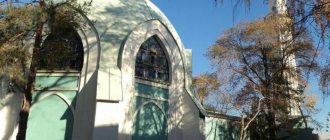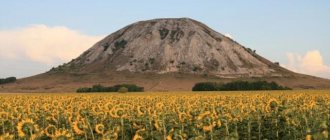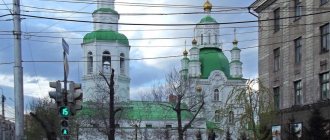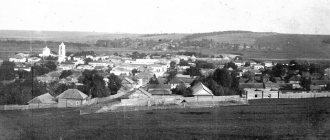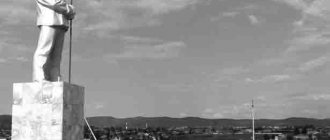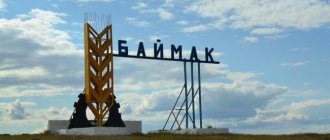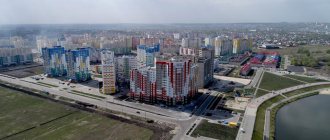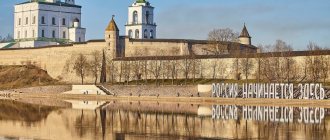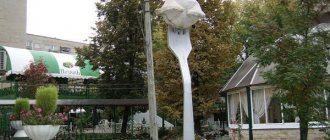Historical information about the city
In the 16th century, the winter residence of the Tatar governor of the ruler of the Nogai Horde .
The name of the city of Ufa comes from one of the versions published in a nineteenth-century memorial book of the Orenburg province: “On the right elevated banks of the Belaya River is the city of Ufa.” The Bashkir word “ufa” itself means “dark water” .
There are historical facts that Ufa has never been conquered by anyone since its foundation. Ufa was protected from attacks by nomads by high walls. Over time, the walls were no longer needed and the city stopped being attacked.
The only exception was the attack during the Pugachev uprising . Ufa withstood these attacks with dignity and repelled both assaults.
In 2015, events of an international scale took place in Ufa. It was a summit of the Shanghai Cooperation Organization and BRICS .
In the mid-eighteenth century, the coat of arms of Ufa was lost in the city of St. Petersburg. In return, they tried to create a coat of arms with a new image - in the form of a white horse running across a red field. Local Bashkirs refused the new image on the coat of arms. Half a century later, the old coat of arms was restored. It again depicted a wild animal that lives in the local forests - a marten.
Headquarters of URALSIB Bank
Headquarters of URALSIB Bank
Headquarters of URALSIB Bank in the city panorama
The building, which is the headquarters of the largest bank URALSIB, is the largest in Ufa. The tower consists of 20 office floors and one technical floor. The wavy structure under the roof of the structure gives it a very original look. The bank building serves as an extension to the old two-story brick building, which housed the second Mariinsky Gymnasium in the 19th and 20th centuries. Now this architectural monument has been restored and looks quite harmonious in combination with a modern skyscraper.
Interesting facts about buildings
Ufa occupies an area of more than 700 square kilometers . The capital of Bashkiria is considered the fourth longest city in Russia. The area of the city can be compared to the country of the Kingdom of Tonga, located in the Pacific Ocean. The capital of France, Paris, can be located on the territory of the city seven times .
There is amazing data about the presence of a huge cave system and adits . They are used to produce gypsum. At the moment, all existing entrances to the caves are closed with plugs, with the exception of one. One of the caves is used as a storage room. The exit from this cave is protected by a huge gate through which large trucks pass. The longest cave is Dudkinskaya . The length of this cave is more than two thousand meters . The entrance to the Dudkinskaya cave is closed with a plug. Other caves are no more than 800 meters .
The city has preserved many buildings of historical value. Private old houses can be found among tall new buildings.
The tallest building in the city is the office of Uralsib . The building of this bank has 26 floors and a height of about 100 meters . This structure was considered the tallest building in Russia outside of Moscow in the early 2000s.
Ufa is the only Russian metropolis that does not have isolated pedestrian streets without car lanes along them.
The city has the oldest building in which a residential building was located. It was built in the 18th century and is located on October Revolution Street. A residential building with one floor has historical significance due to the fact that the famous talented commander Alexander Suvorov .
Gostiny Dvor
A favorite place for residents and one of the main attractions of Ufa, Gostiny Dvor is located in the historical center of the city. The building was built at the beginning of the 19th century, but today it houses modern shops and an entertainment and business complex. It is this combination of historical architecture and modernity that makes this place so attractive and popular.
It is worth noting that fairs have been held in Gostiny Dvor from time immemorial. Merchants from all over Russia and Europe came here, and then it became an elite place for the governor, his entourage and wealthy merchants to live. In Soviet times, it was repurposed as workshops and factory premises, as a result of which it completely lost its former appearance. They even wanted to demolish the building, but city residents came to its defense. As a result, it was reconstructed and made the main cultural and business complex of the capital.
8
Industry in the city
The environmental situation in the Bashkir capital cannot be called favorable. There are several oil refineries in the city. Residents of Ufa constantly report the presence of unpleasant odors in the air.
The development of the oil industry in the city does not affect the pricing of gasoline. The price of fuel here is higher than in many other Russian cities.
Bashkir Drama Theater named after. Mazhit Gafuri
Bashkir Drama Theater named after. Mazhit Gafuri
Bashkir Drama Theater named after. Mazhit Gafuri: night shot
The modern building of the Bashkir Academic Drama Theater named after Mazhit Gafuri, located on the site of the Resurrection Cathedral dismantled in 1932, bears the proud title of an architectural monument and is considered one of the main symbols of Ufa. The theater includes a spacious foyer with a cloakroom, a buffet, rehearsal rooms and a main hall with seating for 620 spectators.
Population of Ufa
Half of the city's population is Russian . The remaining peoples living in the city are Tatars , Bashkirs , as well as representatives of other nationalities.
Ufa people are very hospitable . They also love to cook, especially national Bashkir dishes. National cuisine includes dishes made from horse meat, dried goose, and beshbarmak soup. Bashkirs prefer kumiss and ayran among drinks. And of course, like any oriental cuisine, various flour sweets: baursak, chak-chak.
Bashkiria has three more holiday dates than Russia. Bashkirs rest during the holidays of Eid al-Adha , Kurban Bayram and Republic Day .
Mansion house E.A. Ponosova-Mollo
Mansion house E.A. Ponosova-Mollo
Mansion house E.A. Ponosova-Mollo
Mansion house E.A. Ponosova-Mollo in the Kirov region was built by order of the merchant and miner S.S. Manaeva for merchant E.A. Ponosova-Mollo in 1910. The mansion house became the first building in the Art Nouveau style in Ufa. The building consists of two floors, the entrance is located in the central part, there is an external porch in the form of a two-column portico with square columns and a triangular pediment. The main façade is decorated with rustication, artistic cornices, moldings and window casings. On the territory of the mansion there is also a garden, a fountain and utility rooms. Today this building houses the Museum of Archeology and Ethnography.
Other interesting facts
- The symbol of the capital of Bashkiria is the marten . This wild animal can often be found in local forests.
- Each airport has a three-letter designation. Moreover, only the Ufa airport code has a code that is completely identical to the name of the city - UFA .
- The first mosque in the city was built in the mid-nineteenth century. It is located on Tukaev .
- The Bashkir capital is divided into two parts by two rivers - Ufa and Belaya . One part is considered central, the other - outskirts.
- The length of the city embankment on the Belaya River reaches 400 meters .
- In Ufa there are embankments along the Ufa and Belaya rivers. They are located in different parts of the city. The embankment of the Ufa River stretches in the Sipailovo area. The embankment along the Belaya River is located near the Friendship Monument.
- Once in the city, during winter frosts, a case was recorded when the thermometer dropped to -48 degrees Celsius .
- Ufa is considered one of the most spacious cities in Russia, since per resident there is approximately 700 square meters of city area.
- For the first time, the TIN (individual taxpayer number) was tested in the capital of Bashkiria.
- Three avenues have been built in Ufa. The main thoroughfare in the city is Oktyabrya Avenue , its length is about nine kilometers. Local residents simply call this highway “the avenue.” The second longest is Salavat Yulaev Avenue . This is one of the new broadband roads located in the city center. And the third is Torgovy Prospekt , located in an area remote from the center.
- Ufa is represented by the famous hockey club called “Salavat Yulaev” . This club took pride of place in various championships, including in the 2007/2008 season it became the Champion of Russia, and in 2010/2011 the winner of the Gagarin Cup . Therefore, there are a lot of hockey fans among local residents.
History of creation
Modern Ufa
Ufa is the subject of controversy among many historians, primarily due to the date of the city's founding. 1574 is an officially recognized date, since it was in this year that the first mention of the modern capital of the Republic of Bashkortostan appeared in the chronicles. However, during excavations on its territory, remains of settlements and forts were discovered that date back to the distant Mesolithic era.
In the 16th century, the Bashkir tribes made a decision that turned out to be significant for the further history of the entire people. Tsar Ivan IV, known as the Terrible, conquered the Kazan Khanate and sent letters inviting people to come to the Tsar and bow their heads. Then every ruler can count on royal mercy. This is what the Bashkirs, who were previously under the rule of the Khanate of Kazan, did. Other Bashkir tribes followed their example, and by 1557 the territory of the modern republic voluntarily joined the Russian state.
In 1573, the Bashkirs turned to Ivan the Terrible with a request to build a fortress on their land. The territory was managed from Kazan and due to the distance of 600 km there could not be effective management. The king heeded the requests and in 1574 the construction of a fortress began on Mount Turatau , headed by Mikhail Alexandrovich Nagoy, a famous Russian governor.
Ufa like a fortress
An interesting fact is that the Bashkirs not only initiated the construction of the fortress, they helped in its construction and provided material support. There are isolated cases in history when people voluntarily submit to a foreign conqueror and help him build fortresses on their land.
Cinema "Rodina"
Cinema "Rodina"
Cinema "Rodina": night shot
The Ufa cinema "Rodina" was built in 1954. It included two halls - blue and red, each of which was designed for 350 spectators. Due to the large influx of spectators, it was decided to add another hall with 60 seats, which was called “green”. The cinema building is a massive, tall structure with a pointed roof. The building, designed in the Stalinist Empire style, has white columns with openwork pilasters and large windows around which various decorative elements are located. The main entrance to the building, crowned with a domed arch with openwork ornaments, is also very unusual.
House-museum of the writer S.T. Aksakova
This is a historical and architectural monument.
The Aksakov family settled here when the future writer turned 4 years old. The owner of the house was Sergei Aksakov’s grandfather Nikolai Zubov, who served as an assistant to the governor general.
The museum has 14 halls. The memorial part recreates the interiors of the 2nd half of the 18th century: living room, dining room, tea room, study, children's bedroom, playroom. From them you can imagine how the families of the highest officials of the Ufa governorship lived, and get acquainted with the family chronicle of the Aksakov family.
Corner of the office.
The literary part of the exhibition contains materials about the work of Sergei Timofeevich.
One of the halls is dedicated to the activities of G.S. Aksakov - the son of the writer, the first governor of Ufa.
The second floor of the house is surrounded by a balcony. You can climb it.
You will not be able to view the exhibition on your own. You will definitely be accompanied by a museum employee and offered a detailed or sightseeing tour. Quite an overview.
Church of the Nativity of the Virgin Mary
Church of the Nativity of the Virgin Mary
Church of the Nativity of the Virgin Mary: interior decoration
The Church of the Nativity of the Virgin Mary, built and consecrated in 1909, is considered the largest, most beautiful and spacious Orthodox church in Ufa, which can simultaneously accommodate up to several thousand parishioners. Externally, the church is a sky-blue building with golden domes. The height of the cathedral is 21 m, the bell tower is 47 m. The current appearance of the temple is the result of at least the fourth reconstruction of the building. The walls and floors are decorated with pink Italian, white Greek and yellow Pakistani marble. The green mosaic tiles are Italian serpentinite, and the blue-gray ones are South African granite. All walls and ceilings in the temple are painted.
Church of the Intercession
Church of the Intercession
Church of the Intercession: winter frame
The construction of a stone temple in the style of Russian classicism was started by the Ufa merchant D.S. Zhulyabin. Chapel in the name of St. Nicholas was consecrated in 1817. In 1823, the main temple and the chapel, restored after a severe fire in 1821, were consecrated. The church was closed in 1941 and was used for some time as a pharmacy warehouse. The temple reopened 16 years later, in 1957. Today, the Church of the Intercession is the oldest of all surviving Ufa churches.
Ice Sports Palace "Salavat Yulaev"
Ice Sports Palace "Salavat Yulaev": before reconstruction
Ice Sports Palace "Salavat Yulaev": after reconstruction
The ice sports palace "Salavat Yulaev" with a total capacity of stands of 4 thousand people was opened in 1967. In 1993, another sports ground with artificial ice and stands for 1,500 seats and a second floor with a tennis court were added to the main building. In 2012, in preparation for the 2013 World Youth Championship, another large-scale reconstruction of the Sports Palace was carried out - the roof was replaced, the facade was changed, modern ventilation and air conditioning systems were installed, and the ice rink was equipped with the latest equipment for broadcasting and commentators. During the reconstruction, the total capacity of the Palace was reduced from 4,000 to 3,500 spectators.

